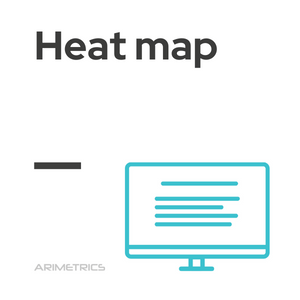Definition:
A heat map is a graphical representation that uses colors to show levels of activity. Generally, dark colors are used to indicate low activity and bright colors are used to indicate high activity. There are several color schemes that can be used to illustrate a heatmap, each with its own advantages and disadvantages. Maps using rainbow colors are common, as humans can distinguish more shades of color than shades of gray, which presumably increases the amount of perceivable detail in the image.
Applications of heat maps
Heat maps are very useful tools to optimize the usability of a web page, since they provide information on the exact points that capture the user’s attention through their interactions and behavior patterns. This has made it possible to determine, for example, that the usual reading pattern on the Internet is in the shape of an “F”, and that the ideal text should not exceed 50% of the length it would have in a printed medium, according to Jakob Nielsen. Although not completely reliable on their own, heat maps on a website are often complemented by other forms of web analytics and tools from disciplines such as web analytics and CRO. The most common types of heat maps are based on user clicks, but eye-tracking techniques can also be used to monitor the exact points on the web page where the eye is focused. Other types include maps based on mouse movement or page scrolling (scroll), which measure how far on the screen the user reaches.
Types of heat maps
We can classify heat maps as follows:
- Click heat maps: These maps show where users click most frequently on a page. They are useful for identifying which elements on a page capture the most attention and whether users are interacting with the desired elements, such as buttons or links.
- Eye-tracking heat maps: Use technology that tracks users’ eye movements to determine which areas of the page they focus on the most. This type of map is valuable for understanding how users visually process information and which parts of the page capture their attention.
- Mouse movement heat maps: These maps record cursor movements as users navigate the page. Although they do not always accurately reflect the user’s gaze, they can provide clues about interest and attention in different areas.
- Scroll heat maps: These measure how far down the page users scroll. They are useful for determining whether users are seeing important content further down the page and for adjusting the layout or placement of content based on this data.
Main heat mapping tools
Among the most used tools to analyze heat maps we can highlight:
- Hotjar: One of the most popular tools, Hotjar offers heat maps of clicks, mouse movements and scrolling. It also includes additional functionalities such as user session recordings, surveys and feedback forms.
- Crazy Egg: This tool provides heat maps that show where users are clicking, as well as scroll maps. It also offers a “confetti” feature that allows you to view clicks segmented by traffic source or device.
- Lucky Orange: In addition to heat maps, Lucky Orange offers session recordings, live chat, surveys and conversion funnels. It is a complete option to understand user behavior in real time.
- Mouseflow: Mouseflow combines heat maps with session recordings, conversion funnels and form analysis. Its heat maps include clicks, scrolling, mouse movement and attention.
- Inspectlet: This tool focuses on session recordings and heat maps to provide a detailed view of how users interact with a website. It also includes advanced segmentation capabilities to analyze the behavior of different user groups.
- VWO (Visual Website Optimizer): In addition to A/B testing, VWO offers heat maps that help visualize user behavior. It allows you to analyze clicks, scrolling and mouse movement to optimize web design.

